WeChat has 109 emojis, 40 of which are completely unique to the platform and 10 which are deceptively confusing.
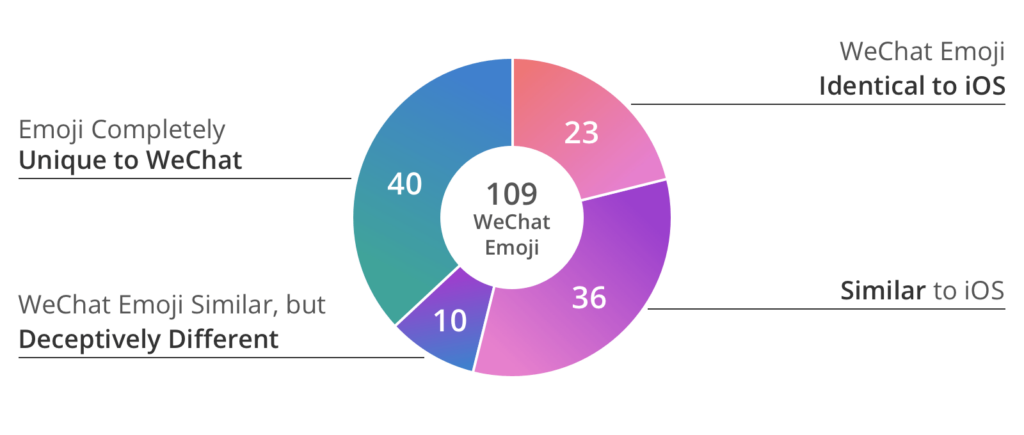
Once used mainly by teenagers, emojis now are completely mainstream and in some instances, their meaning and usage are the subject of fierce debate. WeChat emojis can harbor secret meanings and be indicative of your age and gender. Concerned yet that you’ve been saying things you don’t mean?
Originating in Japan in the late 90’s as combinations of punctuation, emojis add emotive expression to otherwise flat text messages, remember this one ¯\_(ツ)_/¯? They can be used individually to emphasize emotion or strung together to form near-complete sentences. In 2015 the Oxford dictionary even made 😂 ‘face with tears of joy’ their word of the year. But just as flipping someone a thumbs-up in real life can have VERY different meanings across cultures, the nuances of emojis also have deep ties to culture and language.
Consider a smily face from iOS and a smiley face from WeChat; they look similar, but ask any Chinese post-90’s user and she/he will tell you that receiving a smile emoji is not an expression of goodwill at all, in fact, it’s borderline offensive. KAWO has prepared this article on WeChat emojis to keep you out of hot water and minimize awkwardness in your daily life. Enjoy!
Identical
So Similar, You Could be Seeing Double
Let’s get the easy ones out of the way first. You’ll find these 23 emojis are nearly identical — in both appearance and meaning, on both iOS and WeChat.
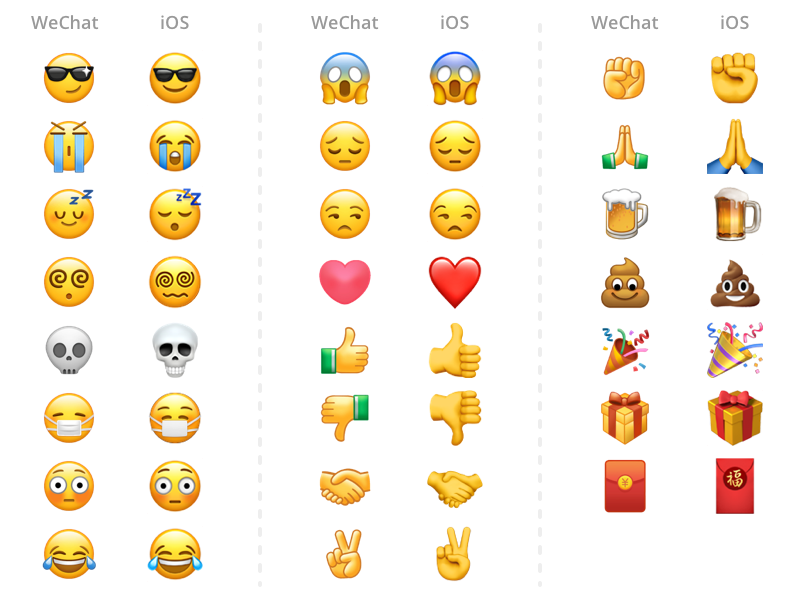
Similar
Same Same, but Different
These 36 emojis look similar to iOS emojis but do you notice the slight differences? Check out the 👌🏼 OK emoji — Chinese netizens will tell you that the WeChat one is a bit more cute (characteristic of Chinese emojis) with the three fingers sticking out and that it more accurately depicts the way someone would use this hand gesture in real life.
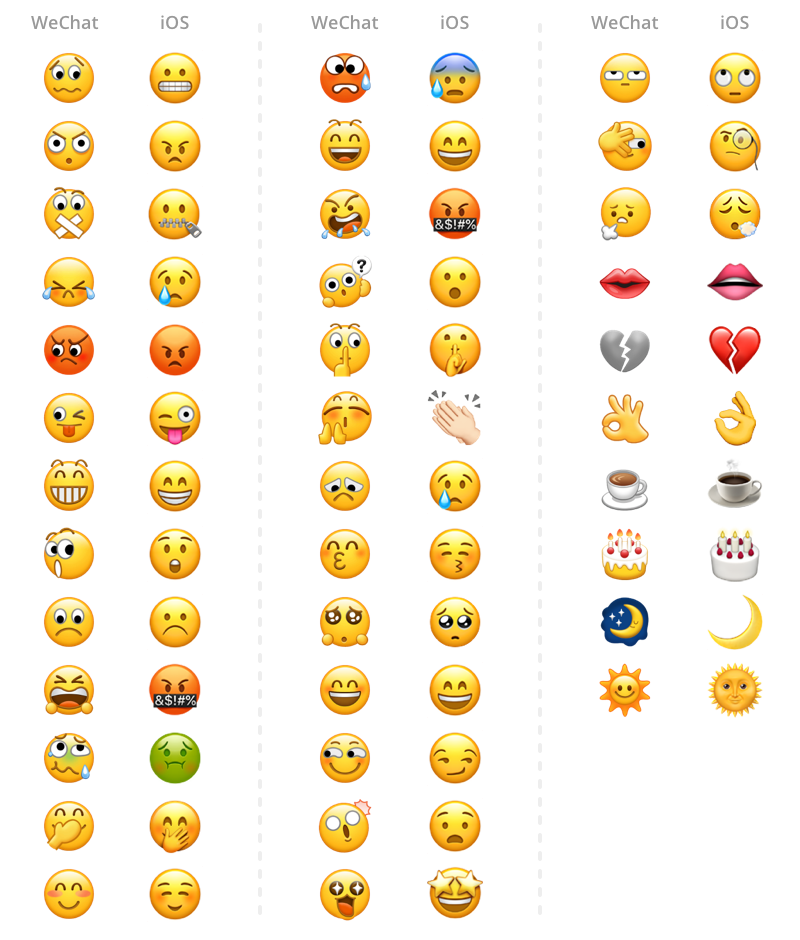
Look Similar, but Different Meaning
Time to Pay Close Attention
If you gloss over this section, don’t blame us for miscommunications and awkward encounters. Let’s cover the 10 emoji you definitely want to check twice before firing off into a chat.
Smile
[Smile] [微笑] wēixiào
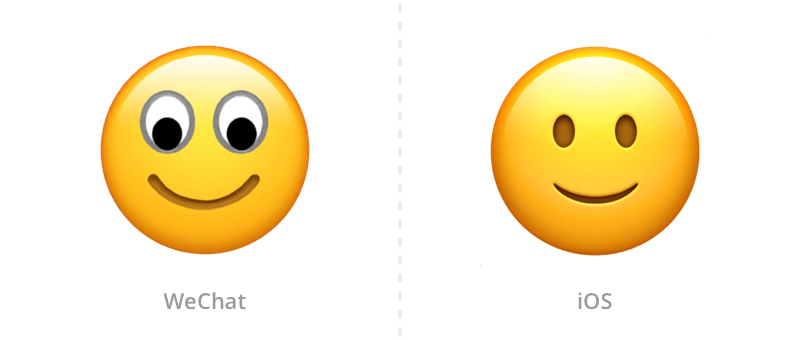
At first look it seems amicable, but this emoji has been the center of heated debate. Chinese netizens attribute the ambiguity of this emoji to the eyes — the mouth is smiling, but the eyes aren’t. Creepy right? While the older generation will use it as a genuine expression of joy, there’s a fair chance that anyone from the post-90s generation will use this to express sarcasm or to add a bit of passive-aggressiveness to the message.
Drool
[Smile] [色] sè
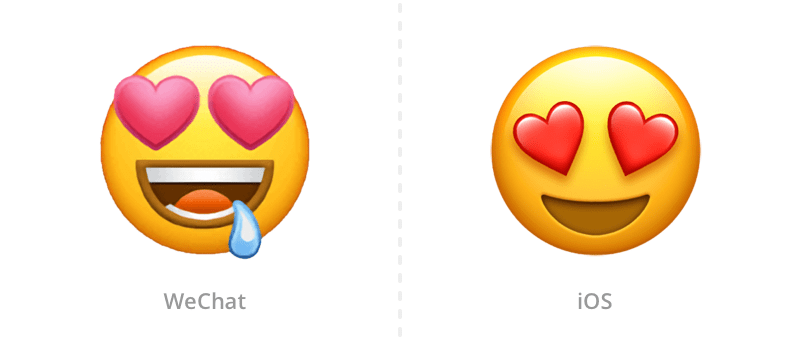
In Chinese, the literal translation of this emoji is “Lust”. Usually used to express extreme joy, satisfaction or approval. Someone sent you a sexy photo? Your friend just shared they are cooking your favorite meal? Droolingggggg!
Shy
[Shy] [害羞] hàixiū
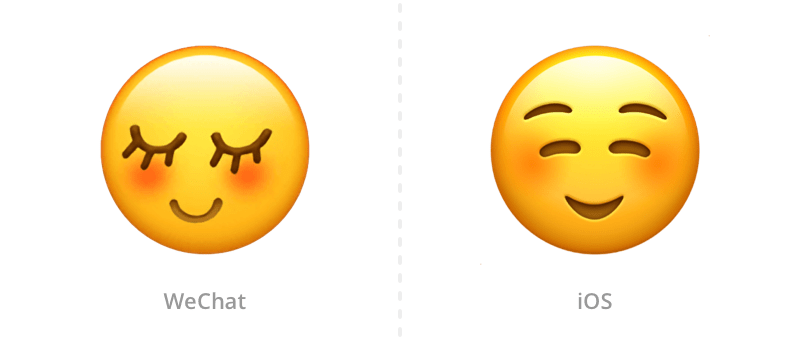
Play it cute to get your way, (卖萌 mài méng) but don’t get it confused with the “blush” emoji!
There’s a few ways to use this one:
- When asking for someone to do you a favor
- To make a humble brag
- Accepting compliments without appearing too confident
Bye
[再见] zàijiàn
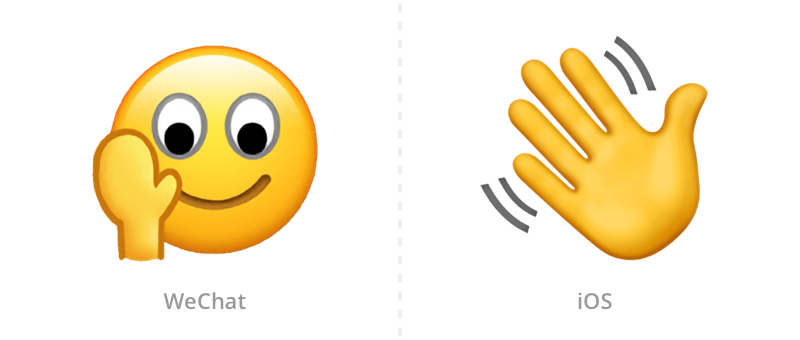
More like ‘talk to the hand’. Even though it looks like a friendly emoji waving goodbye, at its core, it’s that insincere smile emoji we warned you about. More often used among younger generations to signal that the conversation is over. Think twice before sending this one to new contacts.
Rose
[玫瑰] méiguī
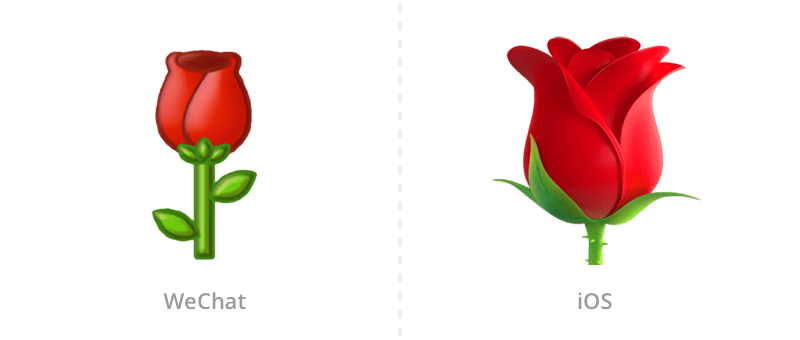
Rose is a flower that conveys beautiful emotions. Often used to express gratitude, blessing and love. Some people will tell you this is more commonly used among older women.
Cleaver
[菜刀] càidāo
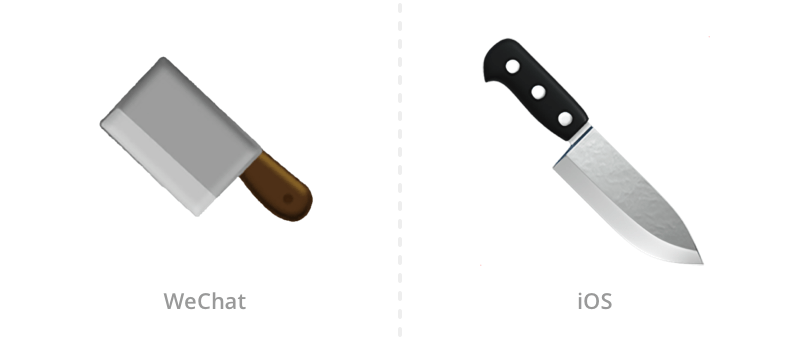
Among close friends you might use it to express anger in a joking way. One Gen Z user enlightened us with her take on it; “When we talk with our friends, we will use a joking tone to express our anger and say: I want to cut you 我想砍了你.” Yikes. A post-90’s user gave us a slightly more PG explanation noting it can be used to express something that makes you feel quite angry or violent.
Our advice is, make sure you have a good understanding of your receiver’s sense of humor (or age) before sending this one…
Bomb
[炸弹] zhàdàn
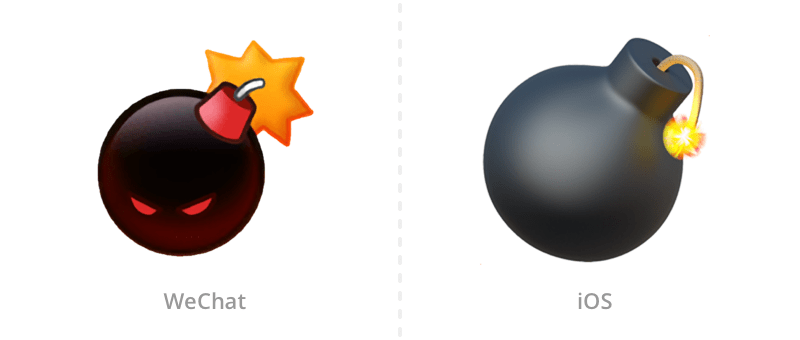
Used to express the emotional feeling of “exploding”. Different from the fireworks emoji which can indicate excitement, the bomb is more cheeky. Let’s say your friend forgot to buy you milk tea, you can say; “I hate you!!! You forgot my milk tea!! [Bomb] “ For an extra bit of fun, if two friends send the bomb emoji at the same time within WeChat, it will trigger full-screen explosion!
Fireworks
[烟花] yānhuā
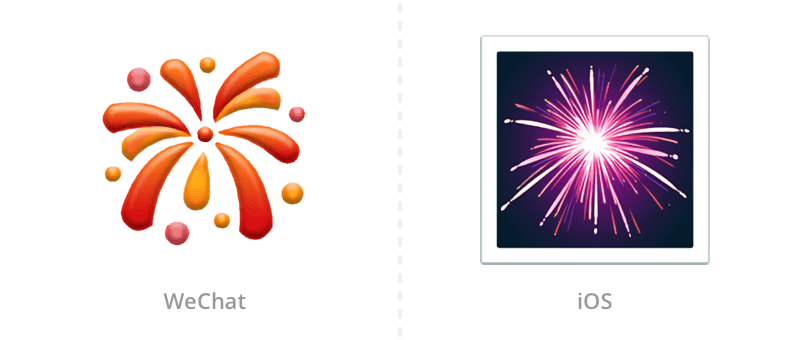
Fireworks represent joy and celebration. This emoji is usually used when good news has been shared or users want to send their blessings.
Firecracker
[爆竹] bàozhú
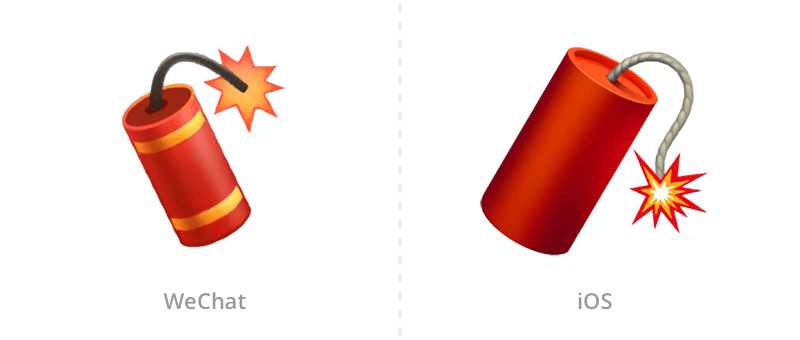
Similar to fireworks. While the iOS emoji looks like a generic explosive, for Chinese people firecrackers are strongly associated with Chinese New Year – so people usually use the WeChat firecracker during this festival.
Pig
[猪头] zhūtóu
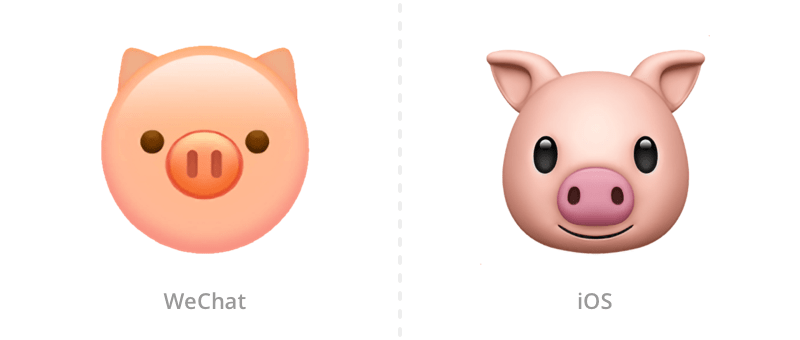
Pigs represent good fortune in Chinese culture. They look cute and naive, which is likable. This emoji can be used in a rather self-deprecating-but-cute way say that you indulged in something too much. Between close friends or lovers it can also be used endearingly when referring to each other.
Emoji Unique to WeChat
When 3,633 Just Wasn’t Enough

You won’t find these ones on iOS! These 40 emojis are unique to WeChat. Dive deeper into the meaning of them and you’ll notice how indicative of Chinese culture they are. Many of these emoji have a discreet, read-between-the-lines implication. Let’s take a look at some of our favorites;
Nosepick
[抠鼻] kōu bí
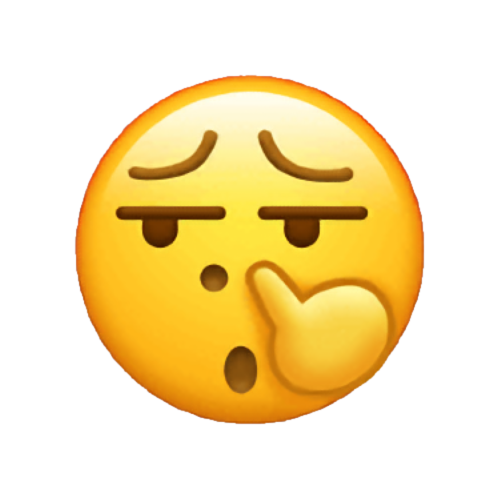
Yes, the “nosepick” is one of those emojis you won’t find in an iOS emoji pack, but its proven to be so useful on WeChat! Save it for situations when you’re not impressed. The perfect response when someone makes a lame joke, suggests a bad idea, when they’re not being helpful… your mild disappointment will be clear with this emoji.
Smug
[傲慢] àomàn

Used when you do not want to continue a topic, or want to express noncommittal attitude about what is being discussed (mostly to disagree). It also can be to add a joking or playful connotation.
Drowsy
[困] kùn

With dark circles, eyes can hardly open (we’ve all been there). This emoji is used to express the state of wanting to sleep but not being able to. It is often used by people who stay up late and work overtime, or get up too early — think the 996 crowd.
These emojis are new additions! A few clearly born of popular online slang or references to current pop culture — WeChat’s attempt to stay hip?
Face palm
[捂脸] wǔ liǎn

One of the most beloved emojis on WeChat. So much, that in 2019, Tencent announced it as their most popular WeChat emoji. You can use the facepalm emoji to show your frustration, to express your bad luck, to laugh at yourself, or simply, when you have nothing to say.
Yeah!
[耶] yé

An ecstatic and happy emoji with two hands holding up peace signs (or V for victory!) – a very common hand gesture in Asia, usually made when taking photos.
Onlooker
[吃瓜] chī guā
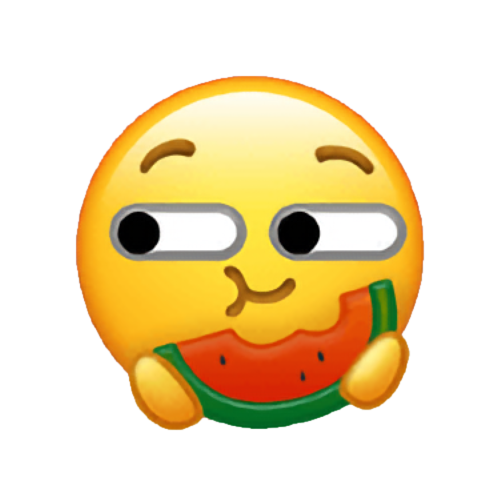
A uniquely Chinese emoji, eating a watermelon slice and looking around smugly. The emoji is a reference to the popular term “吃瓜群众,” which literally means the “melon-eating crowd.” When there is some drama about to go down, send this one.
Emm
[Emm] emm
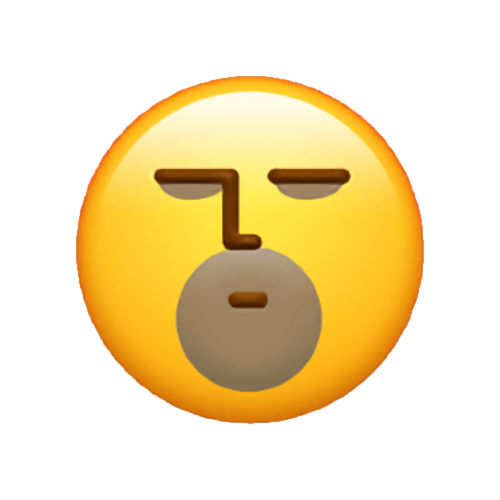
Looks like a dude with a 5 o’clock shadow but used often when you need to reply but cannot find the words. Rather ambiguous when released, but now generally used to express being speechless.
Doge
[旺柴] wàng chái
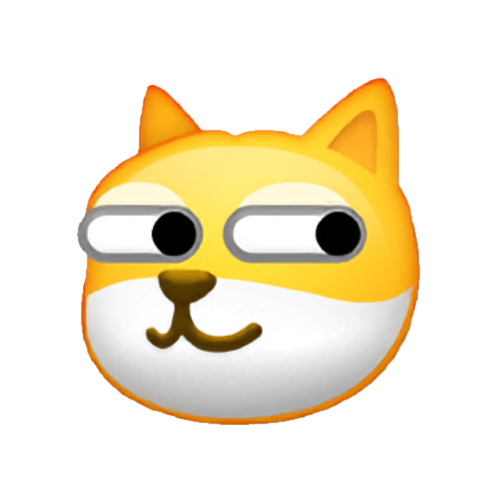
Chinese netizens are obsessed with the doge. So much that nearly any Chinese social media platform has its own variation of doge – even in Weibo and Xiaohongshu. “Doge” serves as a visual response when someone says something interesting.
No prob
[好的] hǎo de

There’s more to this emoji than meets the eye. In its most obvious form, it’s used to express an understanding or commitment to something, but since the emoji is designed a to look a little cunning, it can also be used to subtly confirm you understood what was not explicitly said. In other words, you’ve read between the lines.
Awesome
[666]
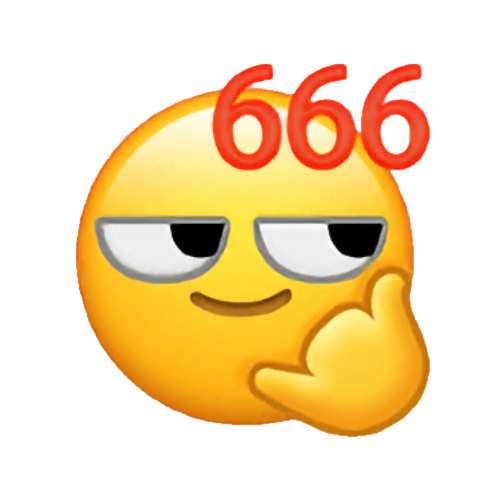
Definitely one that is easily lost in translation – no, your friends are not talking about the devil. This is how you tell someone that they have done well! Phonetically the same as the character 溜 (liū) that means ‘proficient’ or ‘smooth,’ ‘666’ was coined by netizens as a compliment for a task well done in games, an argument well-articulated on online forums, or a sentiment accurately described in the comment section.
Hurt
[苦涩] kǔsè

When you have to smile and take it. Similar to iOS’s new melting face emoji 🫠. Used when you have to smile through the pain, or accept something the way it is even when you don’t want to.
Broken
[裂开] liè kāi

This WeChat emoji comes from a Chinese Internet buzzword: I’ve cracked (我裂开了) or “My heart is broken”. It usually describes someone who is shocked or has encountered unexpected events, which caused their mental state to collapse. The whole body is cracked as if to signal that their heart got broken. We’ve definitely used this one a lot over the past two years.
And Finally…
WeChat Emojis That Changed
Nothing like a makeover! These emoji have undergone a transformation over the years. From anti-corruption campaigns to time-limits on video gaming and curbing of celebrity fan-culture, the Chinese government has made it clear they want to society to follow a high moral standard. This shift has played out even among emojis. Let’s take a look at some of the several noteworthy changes made to long-time WeChat emojis over the past several years;
Commando Quits Smoking
[Commando] [悠闲] yōuxián

Even emojis are taking better care of themselves these days. This soldier face emoji went through a visible evolution and “quit smoking” in 2021. WeChat even got rid of any violence-related meaning in the description (it says “leisurely” right now). This emoji is a mix of determination and, with that smug little smile, signals “I’m badass”.
Is a Frying Pan Safer than a Hammer?
[Hammer] [敲打] qiāodǎ

The original hammer in the ‘hammer’ emoji has been replaced with a frying pan and a little egg. Some say it was done when WeChat redesigned its emojis to make them less ‘violent’. You’ll want to use this one when expressing utter frustration or encountering an absurd situation.
Hiding Evidence of a Crime?
[Cleaver] [菜刀] càidāo

Nearly ten years after the original emoji was included in WeChat’s initial launch the blood specks have been ‘cleaned off’ the cleaver. Today you can use the cleaver, sans blood, but as we mentioned above, proceed with caution when using this one!
Determination Changing With the Times
[Determined] → [GoForIt] [加油] jiāyóu

If you have Chinese friends, you might be familiar with 加油 (“Add oil”) and “fighting”. Both of these phrases serve to cheer on someone. This emoji has a similar meaning: use it to express determination or when doing a pep talk. During the initial COVID outbreak in 2020, this Emoji was updated with a mask which it later lost once things returned to normal.
So What Did We Learn…
When we first started this article we thought we were pretty well versed in WeChat emoji etiquette but boy did we quickly discover just how much we didn’t know! We hope this has been a fun way to uncover how nuanced Chinese language and culture is.
If this has sparked your curiosity don’t worry, the emoji rabbit hole goes deeper! Stay tuned for a part two where KAWO‘ll show you hidden WeChat emoji tricks and introduce some emojis unique to China’s other popular social media platforms such as Xiaohongshu (RED), Douyin (TikTok) and Weibo.







